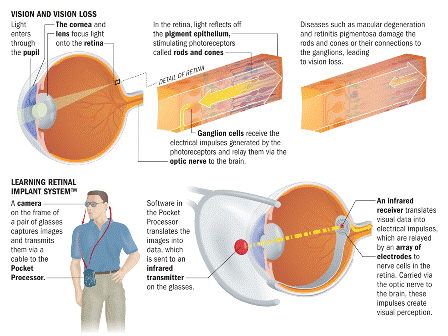| Prosthetics | |
Successful implantation of 50-electrode artificial retina13 January 2006 Zug, Switzerland. Intelligent Medical Implants AG (IMI) has announced that its first-generation Learning Retinal Implant System, containing a 50-electrode device, was successfully implanted in two patients in December 2005. Clinical testing of this device with these two patients will commence this month (January) at the University of Hamburg Medical School ,Germany, under principal investigator Dr. Gisbert Richard, Professor of Ophthalmology. Previously, the most complex retinal implant tested in humans was a 16-electrode array developed by one of IMI's US-based competitors. "This latest milestone further strengthens our position as the global frontrunner for learning retinal implants, which we expect will make it possible for persons who have been blinded by retinal degenerative diseases, such as Retinitis Pigmentosa, to restore some of their lost sight," said Stephan Rietiker, Executive Board Member and CEO, Intelligent Medical Implants AG Also, IMI remains on schedule to initiate pivotal clinical trial in 2006 with its 231-electrode Learning Retinal Implant. In a previous multi-site European clinical study performed with a single-electrode, independent researchers reported that 19 of 20 totally blind persons (95%) were able to see a small point of light. "These blind persons had no visual perception whatsoever, yet nearly all of them were able to 'see' with the stimulation of our single electrode," said Stephan Rietiker. "Considering that the retinal implants of other competing groups are based on cochlear implant technology — a thoroughly dissimilar approach that heightens the risk of adverse events —and given that our first-generation implant is already more than three times more powerful than the competition's, we remain steadfast in our assertion that IMI is now the leader in the race to develop the world's first commercially available artificial vision implant," said Dr. Rietiker. "We reiterate that our initial target market is blind persons with Retinitis Pigmentosa, one of the two most common causes of vision loss in persons over the age of 50 by hereditary degenerative retinal diseases. RP is considered irreversible, unfortunately, and no treatment or cure is known to date. Several million people are affected worldwide," added Dr. Rietiker. "We expect that our Learning Retinal Implant System will some day allow patients to 'see' objects by identifying their size, their position and their movements and shapes. In other words, a previously blind person, using our retinal implant, is expected to be able to move independently in an unknown environment — without the need for a guide dog or cane. No doubt, the development of a wireless visual prosthesis that could be implanted permanently with good results would be a colossal leap forward for the field of artificial vision, and we believe that we are now well down that road." About the learning retinal implant system IMI's Learning Retinal Implant System replaces the signal-processing functions of a healthy retina and provides input to the retinal nerve cells (the ganglion cells) that, in turn, provide input to the optic nerve and the brain.
The System comprises three main components:
The use of a high-speed digital signal processor allows the provision of "intelligent information" to the implant (and the nerve cells) by using tuneable software to approximate the information processing normally carried out by the healthy retina. The entire process enables patients to optimize their visual perception during the learning phase. Indeed, using the patient's feedback on perception as an input for the tuning of The Pocket Processor is the unique, patent-protected feature of the System and constitutes the 'learning' capability of the Learning Retinal Implant System. About Retinitis Pigmentosa More than one million persons worldwide are affected by the hereditary disease, Retinitis Pigmentosa (RP), in which the light-sensitive cells of the retina slowly degenerate and die. In about one-third of the affected persons, the disease leads to total blindness over a period of years. Scientific studies have shown, however, that certain adjoining nerve cells remain intact even in persons blinded by the disease. Most persons with RP develop early symptoms between the ages of 10 and 30. The most common first symptom is difficulty in seeing in poor light, for example outdoors at dusk, or in a dimly lit room. A second symptom is reduction of the visual field, in which sight is lost from the sides, or from above and below. This is often referred to as tunnel vision. All RP conditions are progressive. There is currently no treatment to cure RP or arrest its progress. |
